Young Attorneys Take Over the Bar Association
The Bar Association of San Francisco after 1969
by Jim Brosnahan, 1977 BASF President
In 1969, there were huge demonstrations in the United States with hundreds of thousands of young people protesting the war in Vietnam and institutional racism. They sang Pete Seeger’s song, “We Shall Overcome,” went on strike, held teach-ins, argued with their parents that things had to change, and moved to Berkeley, California, to join the “movement.” The 1968 assassinations of Martin Luther King and Robert Kennedy followed by the election of Richard Nixon, all in a seven month period, left many young with despair coupled with resistance. Small, medium, and large revolutions took over the minds of some young people.
1969 brought its own revolution to the Bar Association of San Francisco (BASF). Six of us in the Barristers Club were fed up with the overly conventional obstacle to our proposed reforms: the BASF board of directors. The old guard had vetoed or modified any progressive programs we proposed. In one meeting, I witnessed those board members defeat a demand to law school deans to increase the number of women and students of color.
The seniors at BASF discouraged us from pursuing prison reform, right to counsel for all who go to court, integration of the legal profession, and a host of programs considered by them to be “too radical.” So Joanne Garvey and I handpicked six trusted members of the 10-person Barristers Board of Directors for a confidential breakfast. Like secret agents we gathered to discuss what to do about the senior board of directors.
My thinking at times reverts to Irish Resistance or simply “the hell with this.” At our meeting we grumbled our frustration at not being able to integrate the legal profession with more women and people of color. Joanne Garvey, a past president of the Barrister’s Club, had been embarrassed by being interviewed on a radio program titled, “Man of the Week.” Joanne became active in the Bar at the very moment a new woman’s rights movement hit the legal profession. Joanne wanted San Francisco’s men’s clubs opened to women so they could conduct legal business at lunch. Betty Friedan had published The Feminine Mystique in 1963, sparking a call for women’s rights. As to me, I too slowly processed my understanding of gender grievances. Joanne helped me get there.
San Francisco lawyers had become deeply involved in the social upheaval of the sixties. Many that I knew personally had gone to Mississippi to work for integration. They returned with harrowing stories of harassment and personal risk. That heightened our feelings on the Barrister’s Board that we should do something to reform the bar. Teachers were experimenting with the poor in poverty programs and the number of supporters of the American Civil Liberties Union swelled after Richard Nixon’s election in ’68. In our minds, equality was in, poverty was out. Young people believed society would change. Many lawyers were demanding social and political reforms “now.”
In the fall of 1969, the San Francisco Bar Association held a lunch at the 1890s-style Palace Hotel, on Market Street. The Palace was symbolically an elegant vestige of old San Francisco. Usually a dull affair with nothing much to report, the president stood and announced a carefully picked nominating committee, anticipating that he would hand the baton to a previously selected legal establishment successor. The people in the room had a dramatically different sartorial look. Members of our six-person junta had organized two hundred liberal lawyers from every law firm, government office, and nonprofit in the city. Each law office became one of our precincts. Our insurgents poured into the lunch. We could see the frowns of senior lawyers at the head table, whispering behind their hands, like Louis XVI in the French Revolution spotting Madame Defarge and whispering, “Who is that?” Some current board members also looked quizzical because they did not know who most of our people were, which demonstrated their isolation.
I looked around the room. One of our revolutionaries stood at each microphone. I reflected on why our lawyers took time to go to an expensive lunch. In their daily practice, they encountered clients who were hurting in many different ways. Every poverty lawyer had to turn away more clients than they could accept. Private lawyers had to turn away more and more people as the cost of litigation rose. The few women in the crowd, including Joanne Garvey, were sick of sexism that often blocked their full participation in law. Lawyers daily saw many kinds of discrimination embedded in law. No young high schoolers living in Hunter’s Point or the Mission District had any hope of becoming a lawyer. Most of all, our lawyers that day came to lunch to demand that a moribund association revitalize itself. I chatted with lawyers I knew who looked at the crowd and were energized by the turnout:
“This is great!”
“About time!”
“Glad I came!”
A sympathetic lawyer, older than most of the group and from a big firm, had agreed to make the announcement. He wore a serious lawyer suit as if he were going to advise the Bank of America. “If I may, I will read the names.” He then read the names of the alternate nominating committee. A Sergeant of Arms counted the raised arms of the voters. If memory serves, the raised hands showed approximately 190 for the insurgent nominating committee and 85 for the seniors. We had captured the nominating committee. As the results were announced, a collective buzz escaped the liberal lawyers. At that moment, we felt the power of possible social reforms. Now, we needed a candidate.
Ten days later, our nominating committee met, searching for an older lawyer with progressive instincts. Someone said, what about Robert Raven? Bob is doing great things with his firm, Morrison and Foerster. He transformed his firm from a very old traditional law firm into a dynamic, growing firm hiring large numbers of young lawyers every year. He will support our reforms.”
The nominating committee selected Bob Raven to run for president-elect. The establishment’s candidate opposed him. That is when I learned that Bob Raven enjoyed fretting.
Before the vote, Bob confided in me, “We have no chance, my running was a mistake.”
“Bob,” I said, “The way we organized, you’ll win two to one.”
He won by two to one.
The bar association has never been the same. As president the following year, Bob changed the association’s agenda. Suddenly a new board of directors embraced the goal of equality, access to justice, and legal reforms of all kinds. For the last fifty years, lawyers in San Francisco have had a place to go to reform all kinds of law.
Jim Brosnahan has served as President of the Bar Association. This article is an adaptation from his book on his trials, which his publisher expects to come out next spring.
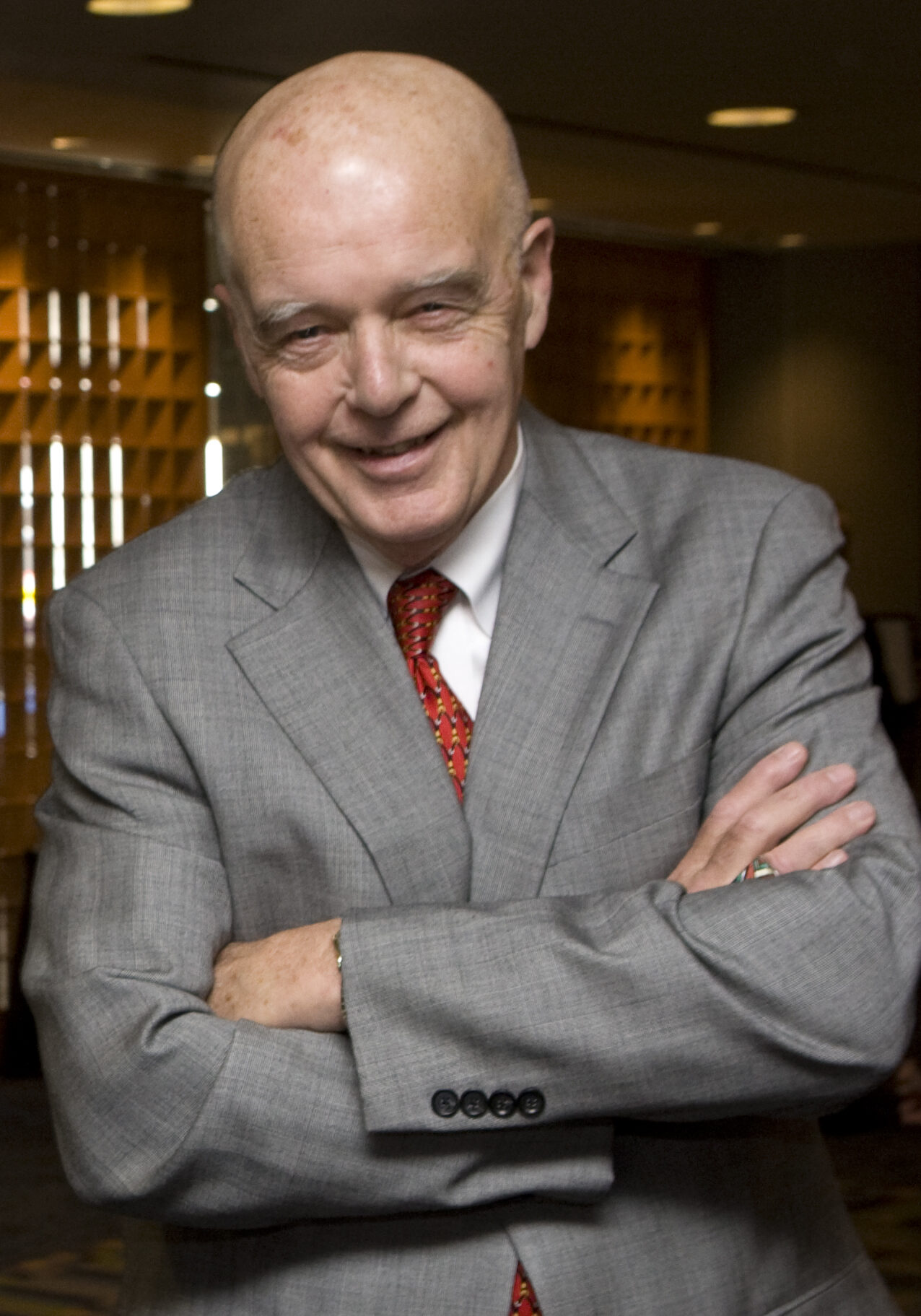
Jim Brosnahan at BASF's 2009 Annual Luncheon
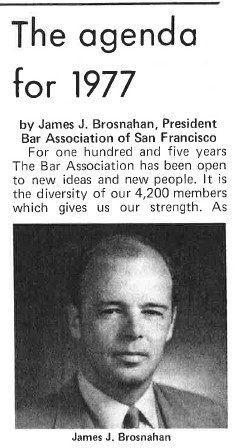
From the December 1976 In Re column by then-incoming President Jim Brosnahan, outlining his vision, which included a pledge to "provide full legal services to all those who need them. Any program that falls short of this commitment leaves us uneasy as lawyers and as human beings."

Jim Brosnahan carries a copy of the U.S. Constitution in his shirt pocket. In 2016, he explained to BASF why: “We had a case, John Walker Lindh, right after 9/11, ‘The American Taliban,’” Brosnahan said. He was in Virginia with his team, and on a rare day off, they visited the home of Thomas Jefferson. “They were selling copies of the Constitution, and a team member bought me one and put it in my pocket.” Brosnahan has been displaying it in his pocket ever since.
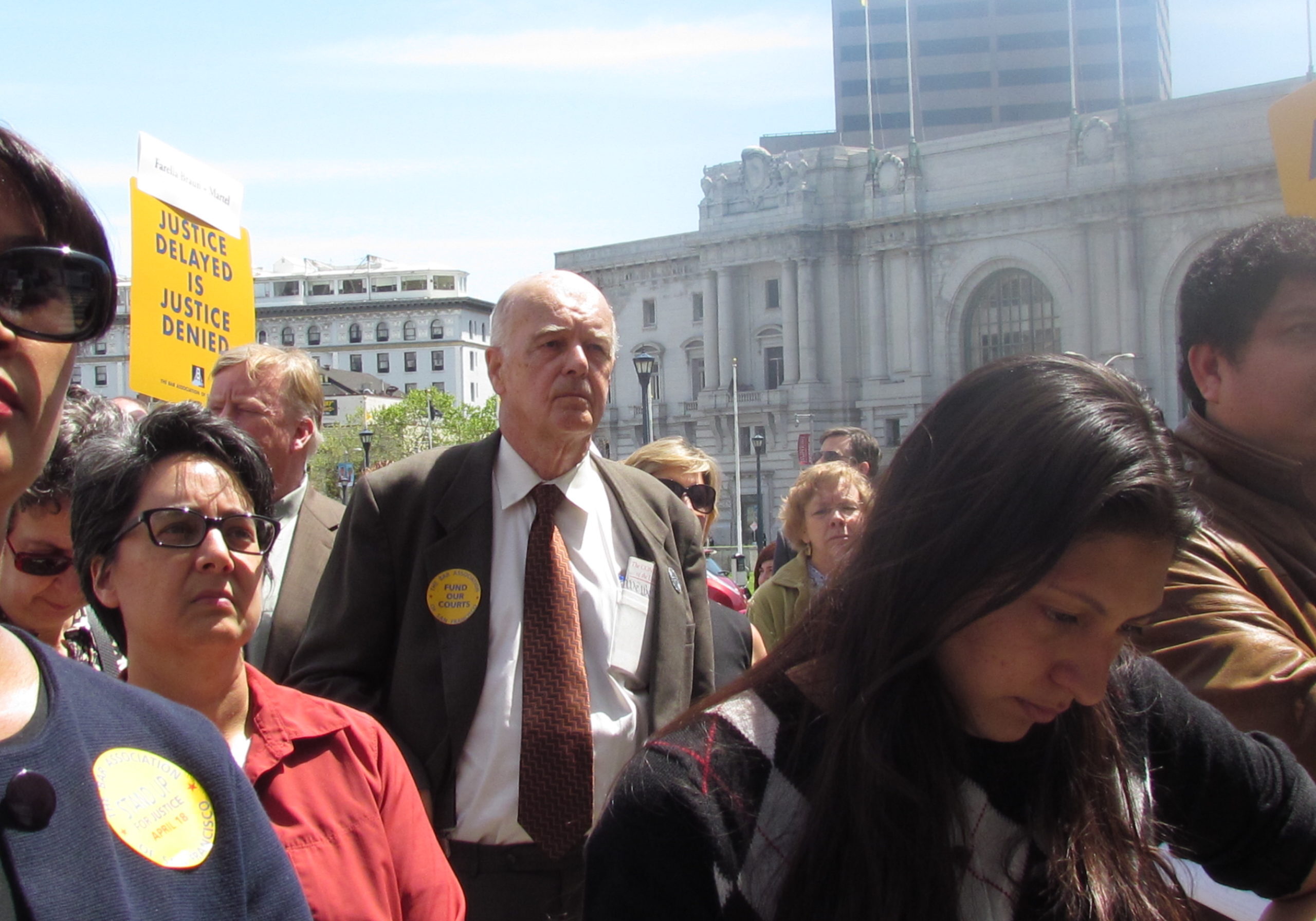
Jim Brosnahan, center, at the April 18, 2012 San Francisco "Stand Up for Justice" rally to protest cuts to court funding and access to justice.
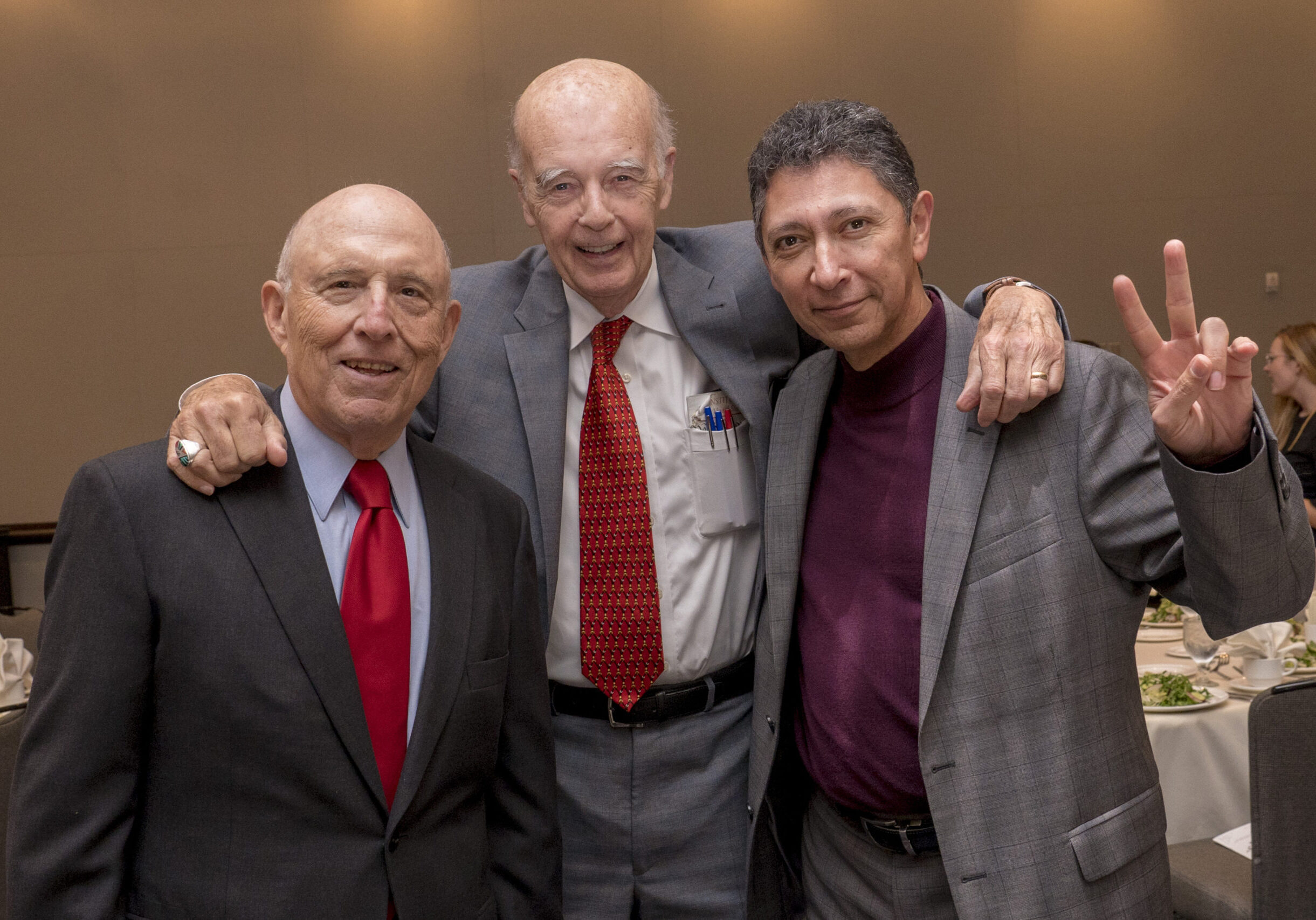
Jim Brosnahan, center, with two fellow past presidents, Mel Goldman, left, and Arturo González, right, all of Morrison & Foerster.
More photos from our archives:
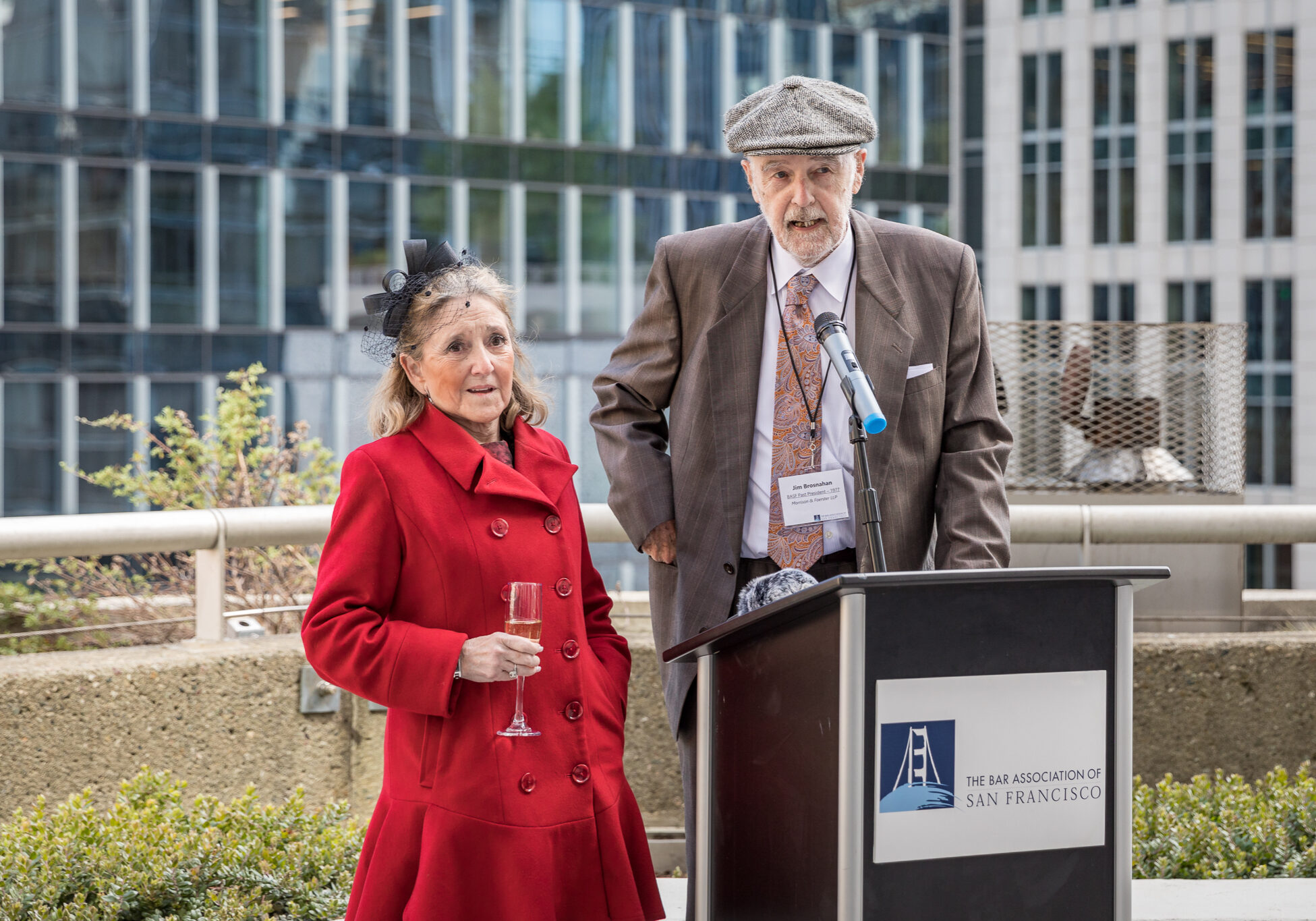
From left, former BASF Executive Director Dru Ramey and Jim Brosnahan at BASF's 150th Anniversary reception on April 27, 2022.
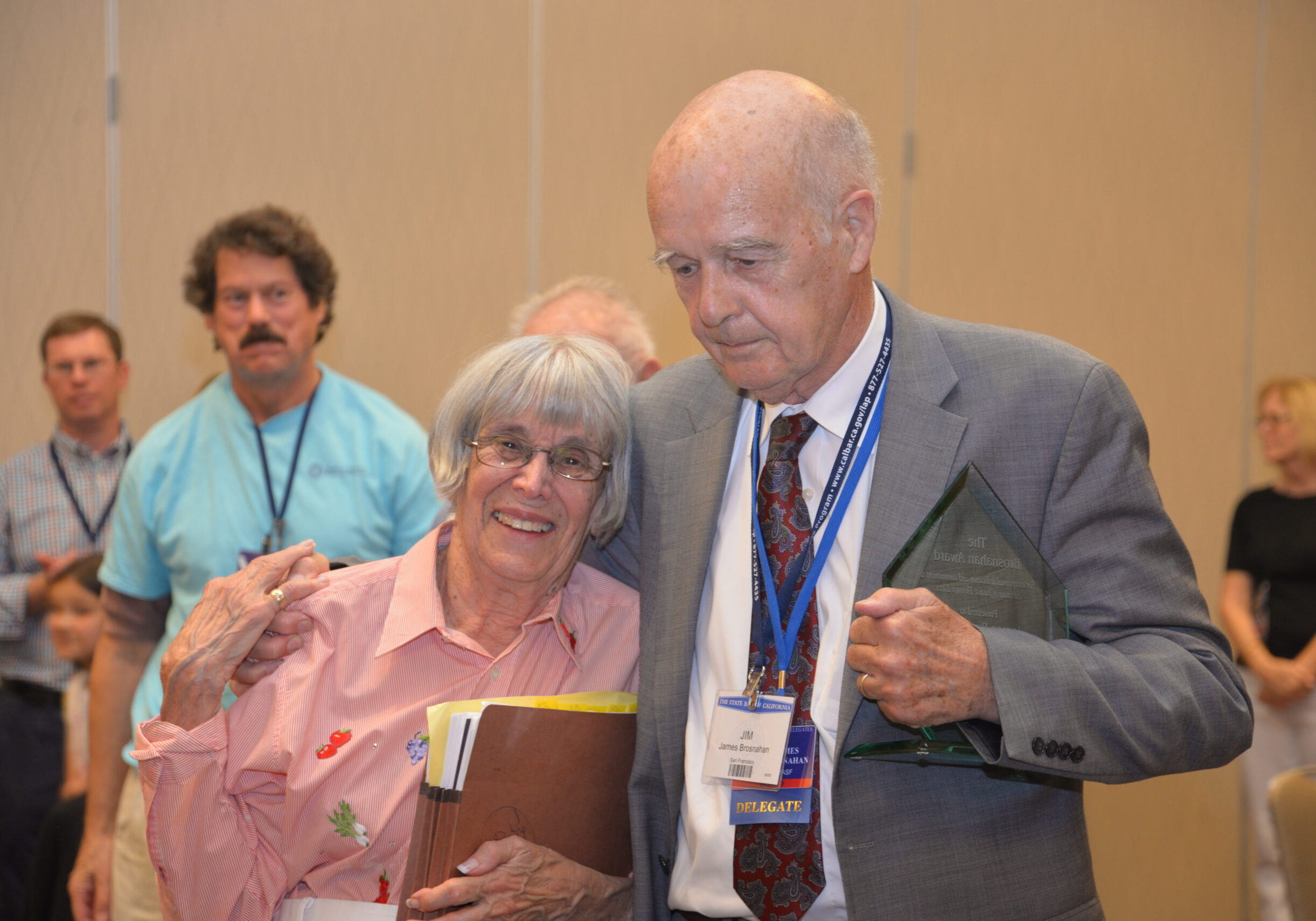
The Honorable Carol Brosnahan and Jim Brosnahan at the 2016 Conference of California Bar Associations, which meets once a year to debate and vote on proposed legislative reforms. Jim Brosnahan, who had participated in 51 of the last 54 conferences, was the inaugural recipient that year of the BASF Delegation’s Brosnahan Award for Exceptional Dedication and Commitment to the Cause of Justice Through Laws.
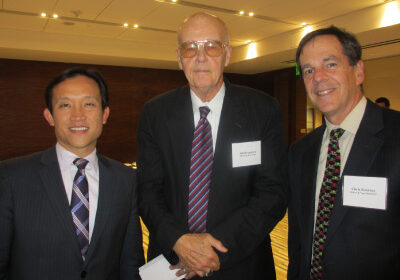
From left, then-Board of Supervisors President David Chiu, Jim Brosnahan, who took the lead in drafting the city’s Right to Counsel in Civil Matters Ordinance, and 2013 BASF President Chris Kearney celebrating a successful first year of the Right to Civil Counsel Pilot Program in 2013.
Join the celebration
Visit the History Archive
Throughout this year, we are adding historical documents and articles to the newly created history archive in our online documents library.
Share a Memory
We'd love to hear from you. If you have a story, article, or historical photo related to San Francisco legal history, we'd love to hear from you.
